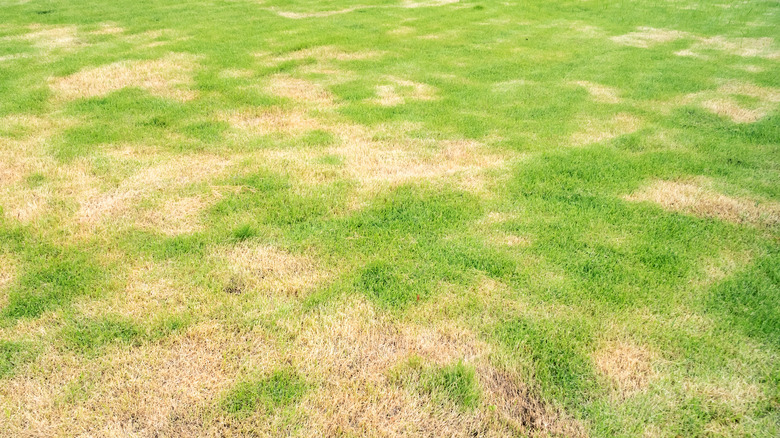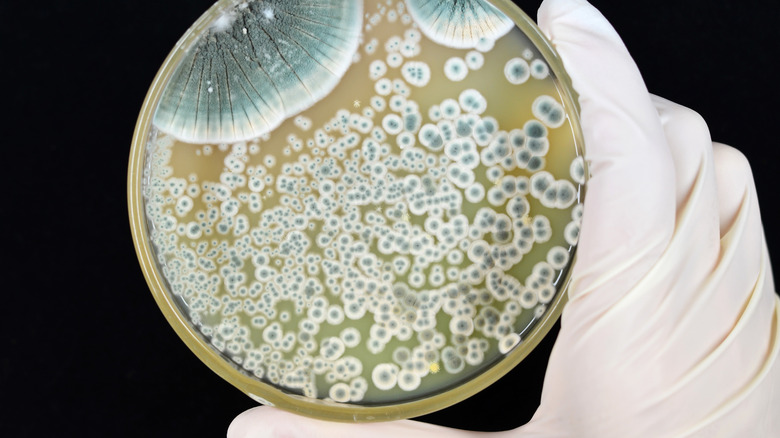According to pests.org, Scarabs were worshipped by the ancient Egyptians and some pre-Colombian American civilizations, as well as inspiring philosophies in ancient China. Unfortunately, this ancient allegory has become something of a modern-day monster. As Turf magazine explained, the most prolific pest tormenting American lawn owners is white grubs, the common name for scarab beetle larvae, per WVU Extension. Most scarab beetles aren’t pests — but most lawn grubs are from the scarab family, so understanding them is key to avoiding the unsightly patches of dead, spongy grass that they create.
Grub treatments are most effective when larvae are young and accessible. Eggs are laid near the soil surface in summer, and as winter draws closer and lawn temperatures drop, scarab larvae burrow deeper into the soil to hibernate, per LebanonTurf. If you want to treat your lawn for white grubs, you need to do it before winter comes. Keep reading for a review of which treatments work best.
White grub identification and mitigation

White grub eggs are laid in the first few inches of lawn soil and once they hatch, they feed on the roots of the grass mainly, which causes patches of damage. According to Cornell University, these areas of damage will easily roll up like a carpet if grubs are really the culprit, as the roots will be almost entirely destroyed. You should also be able to see the grubs when you do this. A healthy lawn can withstand a population of up to 7 grubs per square foot without requiring treatment, according to Clemson Cooperative Extension.
Maintaining a vigorously growing lawn is one of the best ways to mitigate grubs, damaged blades will simply be harder to spot. Investing in overall lawn health is usually a better idea than a carpet-bomb approach unless discovering any damage at all is completely unacceptable. A compromise approach suggested by Iowa State University is to treat spots where you have previously observed grub damage, as beetles tend to return to similar areas each year. Chemical treatments are either preventative or curative. Preventatives are only effective when applied before the summer. Curative treatments are applied to areas where new damage is observed and are effective when grubs are actively feeding. Per NC State Extension this is from August through October, but the exact timing will vary depending on your lawn’s specific climate.
Biological grub control

There’s a misconception that using biological controls over chemical ones is softer or more gentle on pests. According to RHS, biological methods control unwanted organisms by introducing some of their natural enemies. In the context of lawn grubs, that means recruiting diseases, parasites, and predators to feast on scarab larvae. There are two main biological control methods for lawn grub worms — Milky Spore and Nematodes.
Per the University of Florida, the Japanese beetle is the most widespread turf grub. Since the 1940s Japanese beetles have been treated with Milky Spore, a bacteria that attacks only that species. The treatment can be done at any time of year when the ground isn’t frozen, per Garden Guides. However, as pointed out by Lawn Love, it can take up to three years for the treatment to have a noticeable impact on grub populations, and other species won’t be affected.
A newer development in the biological war against white grubs is the use of entomopathogenic nematodes (EPNs). EPNs are microscopic roundworms found in soil, and they are harmless to you and your plants, however, they are naturally adapted to hunt and kill insects in the soil. Before the first frost is the ideal time to apply EPNs, and according to New York State Integrated Pest Management Program, you should be able to observe treatment success in less than a month.



